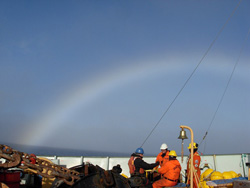Steve Lambert, WHOIAugust 30, 2012The Tokyo University of Marine Science and Technology also had two moorings to deploy during this cruise and Daisuke Hirano from TUMSAT has joined us for that part of the trip. The moorings were designed and constructed at WHOI and deployed by personnel from both TUMSAT and WHOI along with help from crew members of the LSSL. These moorings were deployed at about 76 and 77 degrees north about 90 nautical miles apart. While these moorings are essentially identical to the moorings put in previously there is nothing day-to-day about this kind of work. With the lack of ice here we have had some rough seas and fog so far this cruise and for these moorings we also had some blowing snow. During the deployment we have the releases armed and ready to unlock in case of emergency. At all times there is someone to watch out and push the button to release the two-ton anchor. In order to help that watch stander stay attentive this particular station is rotated out about every hour for coffee breaks and a change of scenery. During this deployment it was a bit cold out on deck. The majority of the MMP shell is held together with nylon screws to prevent corrosion and reduce negative buoyancy once in the water. The hood that covers the electronics is held on with one of these plastic screws and in this case the screw broke while the unit was being lowered into the water. It is believed that with the sea state as rough as it was the MMP slammed the lower bumper and broke off the plastic screw holding it on. The ship's carpenter and photographer Gary Morgan managed to snap a few photos with the unit just below the surface and we could tell from these pictures that the hood had become detached so the entire unit was brought back aboard, assessed, repaired and redeployed. After that we had no more problems and two more moorings are now in place. Last updated: October 7, 2019 | |||||||||||||||||
Copyright ©2007 Woods Hole Oceanographic Institution, All Rights Reserved, Privacy Policy. | |||||||||||||||||



